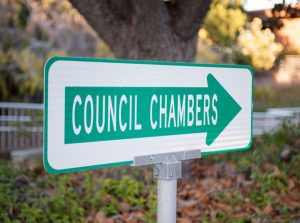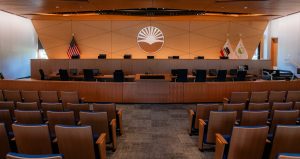During a marathon session that stretched until 2:40 a.m., the Santa Clara City Council approved California’s Great America’s proposal to expand its operations.
The Council Chambers were packed to the brim during the Council’s Tuesday night meeting. Some were barred from entering the chambers, which had reached its 150-person capacity by 8 p.m.
The Council unanimously approved Great America’s proposal to have its zoning designation switched from commercial to mixed use to accommodate the roll out of a public promenade–consisting mainly of restaurants–outside the park’s gates.
The proposal drew heavy fire at a Santa Clara Planning Commission meeting earlier this month when Great America proposed that, in addition to adding new rides and the promenade, it be allowed to operate year-round until 1 a.m., leaving Commissioners and neighbors alike worried about the impact of noise.
At that meeting’s conclusion, the Planning Commission voted unanimously to recommend the project but with the provision that the noise levels would be limited depending on the time of day. However, while Great America changed the proposal slightly from the one presented to the Planning Commission, the recommendation issued to the Council–signed by City Manager Rajeev Batra and Director of Community Development Andrew Crabtree–had no such noise limitations.
Still, the proposal does allow City employees to review any proposed rides or require mitigation measures be taken if an analysis of the ride shows that its noise levels exceed acceptable levels.
Mayor Lisa Gillmor called the park a “jewel in the community” and said the proposal would make it “even better.” She said that while she understands the concerns of the neighbors, the Council trusts Great America will do its utmost to address any issues that arise.
“We don’t need to memorialize them because we have that trust,” she said. “We are going to be responsive to our community, and we are going to hold you [Great America] accountable.”
Erik Schoennauer, land use consultant for Great America, said the park is asking for 30 days during which it can operate rides until 1 a.m., saying that the designation is designed to “balance the need to protect the community with reasonable regulation” and that it is a way to “codify the way those things are done in a way that is respectful.”
The park is able to operate rides until midnight and has no limitation on how late it can have events. However, Schoennauer said the effort is more about drawing patrons to the park during time of year when attendance is low.
While some, including Chris Horton, president of the Santa Clara Chamber of Commerce, spoke in favor of the project, others were not without their concerns–mainly whether the increased operating schedule would create too much noise in the area.
Jennifer Yew, who lives near the park, said she spoke on behalf of 45 dissatisfied residents who, although they support the market promenade, have signed a petition saying they believe proceeding without decibel limits on the noise would be problematic.
According to the park’s environmental impact report, mitigation measures are unable to reduce the noise levels, as well as the greenhouse gas emissions to “less than significant levels.” However, City staff analysis claims that the project’s “benefits outweigh, and therefore override, any impacts that could potentially remain after recommended mitigation measures are implemented.”
As part of the proposal, Great America said that it was willing to put measures in place to reduce the number of miles its employees travel to get to the park by five percent. Although Council member Teresa O’Neill said she would prefer to see that number higher, she eventually capitulated, voting in favor of the proposal, but asking that Great America commit to marketing efforts to encourage its patrons to use mass transit.
‘City of Hope’
Another agenda items that saw much discussion and elicited pointed criticism was one that the Council continued to another date. The “sanctuary city” resolution (a.k.a. the ‘City of Hope’ resolution), brought forth late last year by now Vice Mayor Dominic Caserta, would declare “the City’s policy against local enforcement of civil immigration laws, while permitting cooperation with federal agents in situations involving public and serious crimes.”
Caserta proposed the policy back in December, referring it to a committee. However, the person in charge of logging the minutes to that meeting failed to record the minutes, the Council deemed it best to continue the item until the resolution better reflected Caserta’s intent. Caserta refused to name the city employee who failed to log the minutes, saying he “didn’t want to point any fingers” because the Council meeting was not a “McCarthy hearing.”
The resolution is necessary because so many people have become “triggered emotionally.” Caserta did not elaborate on his intent nor did he mention any specific policy or proposed policy that has caused this reaction.
Police Chief Mike Sellers previously said the resolution is a reflection of how the police department already operates, adding that it does not conduct or cooperate with federal immigration raids.
Still, many members of the public worried about the message the resolution sends as well as what it could mean to any federal funding the City receives.
Jacob Orkis, an immigrant, said 35 of his 40 family members living in the U.S. came to this country legally. He said he would like to see the Council kill the resolution because it is not under the purview of its authority.
“It contradicts law of United States of America, and I still think this is American land,” he said.
Priya Murthy, with Services Immigrants Rights Education Network (SIREN), said her organization supports the resolution. She urged the Council to “take this matter up swifty” because everyone is “on pins and needles” expecting an executive order from the president.
Council mainstay Hosam Haggag, applauded the continuance and said that when the resolution comes back for a vote it needs to have a “tangible impact.”
Councilmember O’Neill said she would like to see how this matter plays out on a state level before making a decisions on the resolution.
Another speaker called the resolution a “partisan agenda.”
“You are out of your orbit,” she said. “We have a democratic process. We don’t bully people and tell them they are bigots by members of this Council.”
The Council pushed back discussion of the “sanctuary city” resolution but did not set a date for that discussion.











0 comments